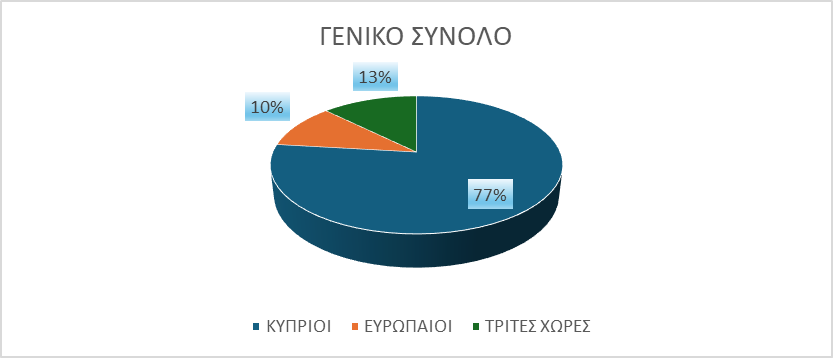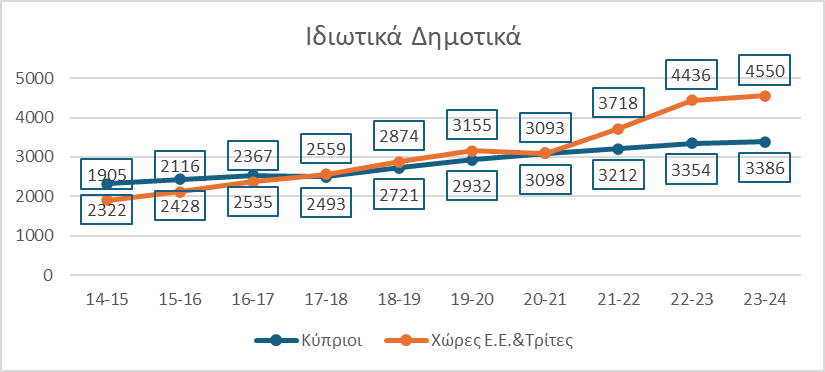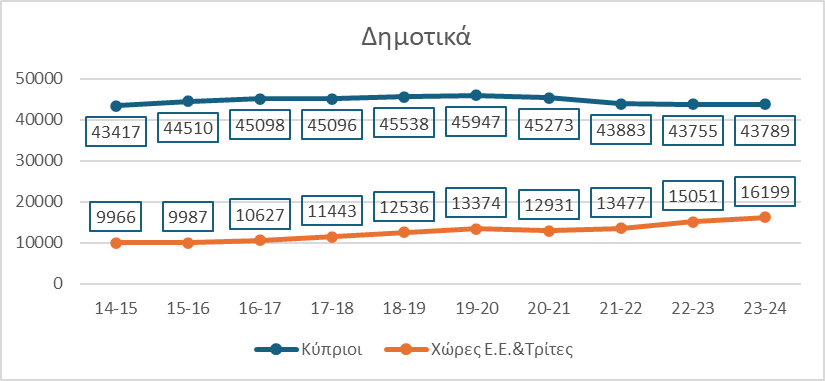Filenews 5 April 2025 - by Theodora Nicolaou
A rapid increase in the number of pupils from third countries attending schools in Cyprus has been recorded in the last decade, while at the same time there has been a steady fluctuation in the number of pupils from EU countries. As far as Cypriot students are concerned, their numbers are decreasing at some levels, with the most important being recorded in high schools.
According to a study "Distribution of pupils' origin 2014-2024", which was carried out by the Institute of Demographic and Migration Policy of Cyprus and which is based on data from the Ministry of Education, in public education, pupils from the EU and third countries constitute 26.4% of the general population in kindergartens, 22.4% in primary schools, 20.6% in public secondary schools, 16% in Technical Schools and 15.% in high schools. In the general public education sector, foreign pupils make up 23%. At the same time, in private education, students with an immigrant background in primary schools constitute the majority.

The study also records both the particular case of Limassol, which holds the lion's share of foreign students in private education, as well as the disproportionate percentages of students from third countries and the EU that concern the Paphos District as a whole in relation to the other Districts.
They more than tripled in high schools
In public secondary schools, there is a steady increase in all provinces of children coming from EU countries and third countries, since in 2014 they totalled 2841, while ten years later they increased to 4968. As far as students from EU countries are concerned, and while Nicosia remains stable with fluctuations, the other districts show a slight increase, with their total being formed from 2028 in 2014 to 2351 in 2024. The above difference in the general total number of foreign pupils is mainly due to the more than tripling of children from third countries, since from 813 in 2014 they increased to 2617 in 2024.

At the same time, the data show that there is a rapid increase in students from third countries in high schools as well, from 575 (2014) to 1166 (2024). In the total number of foreign students (from the EU and third countries) there is again an increase from 1711 to 2736.

As far as Technical Education is concerned, in 2014 the total number of children from EU and third countries amounted to 493 and ten years later to 731, which is due to the increase recorded in the last decade by pupils from EU countries (from 340 in 2014 to 534 in 2024).

The number of pupils with a migrant biography has been on the rise in the last decade in primary education as well. Specifically, foreign pupils in primary schools rose from 8061 to 11649 and in kindergartens from 1739 to 3472.


They constitute the majority in private primary schools
The increase in private schools for children from the EU and third countries in this decade is geometric. In detail, in primary schools they rose from 1905 (2014) to 4550 (2024), while in high schools from 1105 to 4237.

This increase has resulted in pupils from the EU and non-EU countries currently making up 57.3% of the general population in primary schools in private education. As far as private secondary schools are concerned, the percentage of these children amounts to 37.1%.

The lion's share is held by Limassol with 2505 foreign students in primary schools and 2199 students in secondary schools.
Paphos holds the reins
The Paphos district holds the reins in terms of the percentage ratio of foreign and Cypriot students. In primary and kindergarten schools, students from third countries and EU countries in Paphos make up more than 40%, in public secondary schools almost 40% and in high schools they reach 35%. At the same time, in the rest of the provinces, at all levels of public education, foreign students range between 16%-22% of the total number of students.


Reduction of Greek Cypriot students in high schools
The significant decrease in Greek Cypriot students in high schools from 17506 to 14809 is worrying, a fact that reveals a low birth rate in the years from 1997-2000 to the years 2007-2010.
A slight decrease in the last decade has been recorded by Cypriot pupils at other levels of public education, such as in secondary schools (from 19901 to 19170), in primary schools (from 41095 to 40403) and in kindergartens (from 10327 to 9677).
The following tables present the data of all education, public and private, in the last decade:


"Given the demographic alteration"
According to the Cyprus Institute of Demographic and Migration Policy, the study – which records the attendance trends of children from third countries, European countries and Cypriot citizens over a ten-year period – shows that demographic change is a given. As the president of the Institute, Andreas Morfitis, told "F", this study is the first part, as it will be followed by a second one that will concern the effects.
